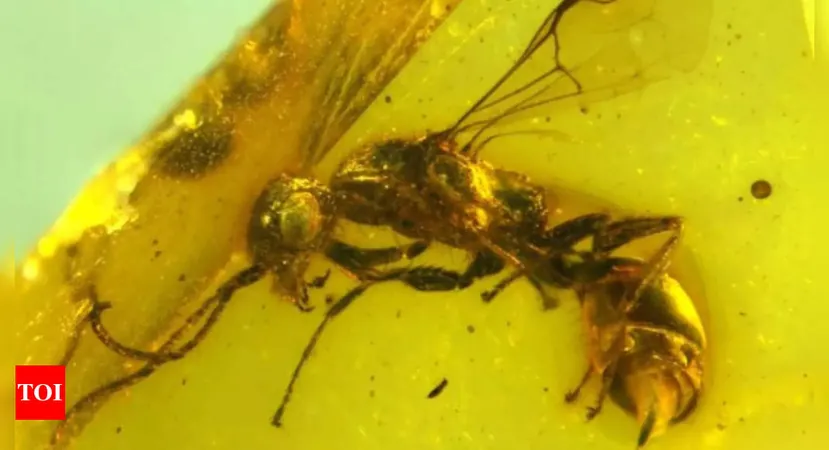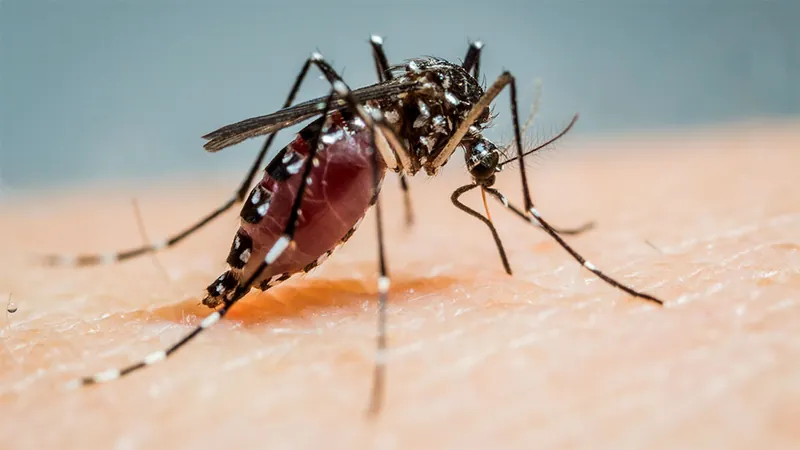
Jurassic Marvel: A 99-Million-Year-Old Wasp with a Venus Flytrap-Like Structure Discovered in Amber!
2025-03-28
Author: Olivia
Jurassic Marvel: A 99-Million-Year-Old Wasp with a Venus Flytrap-Like Structure Discovered in Amber!
Scientists have made a jaw-dropping discovery of a unique parasitic wasp that roamed the Earth during the Cretaceous period, approximately 99 million years ago. This remarkable specimen, named *Sirenobethylus charybdis*, has been encased in amber found in Myanmar, revealing an evolutionary adaptation unlike anything seen in modern insects.
The standout feature of this ancient wasp is a peculiar structure on its abdomen that resembles a Venus flytrap. Researchers believe this intriguing design enabled the wasp to capture and retain other insects, potentially using them to protect and nourish its larvae. This astonishing finding sheds new light on the evolutionary traits that existed among insects millions of years ago.
The discovery emerged from a study conducted on 16 well-preserved wasp specimens from the Kachin region of Myanmar. One exceptional specimen, purchased by a fossil enthusiast and donated to the Capital Normal University’s Key Laboratory of Insect Evolution and Environmental Changes in 2016, sparked this groundbreaking research.
“My initial thought was that the unusual expansion at the tip of the abdomen was just an air bubble, a common occurrence in amber specimens,” remarked Lars Vilhelmsen, a wasp expert involved in the study. However, after closer examination, he realized this feature was indeed a part of the wasp.
This fascinating structure was shown to be flexible, appearing in various positions across different specimens. "The lower flap that we refer to can either open or close," Vilhelmsen explained. "It was clearly a functional structure meant for grasping."
Since no modern insects possess a feature akin to this wasp's abdominal trap, the researchers had to look beyond the animal kingdom for a comparable function. They eventually drew parallels to the Venus flytrap, a carnivorous plant renowned for its quick-closing leaves that capture prey.
However, there’s a twist—while the plant uses its trap to kill its prey, scientists theorize that *Sirenobethylus charybdis* used its unique structure to latch onto a target long enough to inject its eggs, transforming the unsuspecting victim into a host for its developing larvae.
“Understanding the behavior of an insect that lived 100 million years ago is incredibly challenging,” Vilhelmsen stated. “We had to look for similarities within modern insects or explore the plant kingdom for anything that resembled this structure. The conclusions we reached demonstrate how unique this wasp really is.”
While contemporary parasitoid wasps share certain behaviors, such as cuckoo wasps that lay their eggs in the nests of other wasps, the distinguishing flytrap-like structure of *Sirenobethylus charybdis* sets it apart in the evolutionary timeline. "This is something entirely unique, something I never anticipated seeing, and something that expands our understanding of insect evolution," Vilhelmsen declared with excitement. “It’s a 10 out of 10 for rarity and significance.”
Overall, this astonishing find not only enriches our knowledge of prehistoric life but also underscores the extraordinary diversity of evolutionary adaptations that existed long before humanity. Who knows what more remarkable discoveries await us as we delve deeper into the past? Stay tuned!









 Brasil (PT)
Brasil (PT)
 Canada (EN)
Canada (EN)
 Chile (ES)
Chile (ES)
 Česko (CS)
Česko (CS)
 대한민국 (KO)
대한민국 (KO)
 España (ES)
España (ES)
 France (FR)
France (FR)
 Hong Kong (EN)
Hong Kong (EN)
 Italia (IT)
Italia (IT)
 日本 (JA)
日本 (JA)
 Magyarország (HU)
Magyarország (HU)
 Norge (NO)
Norge (NO)
 Polska (PL)
Polska (PL)
 Schweiz (DE)
Schweiz (DE)
 Singapore (EN)
Singapore (EN)
 Sverige (SV)
Sverige (SV)
 Suomi (FI)
Suomi (FI)
 Türkiye (TR)
Türkiye (TR)
 الإمارات العربية المتحدة (AR)
الإمارات العربية المتحدة (AR)